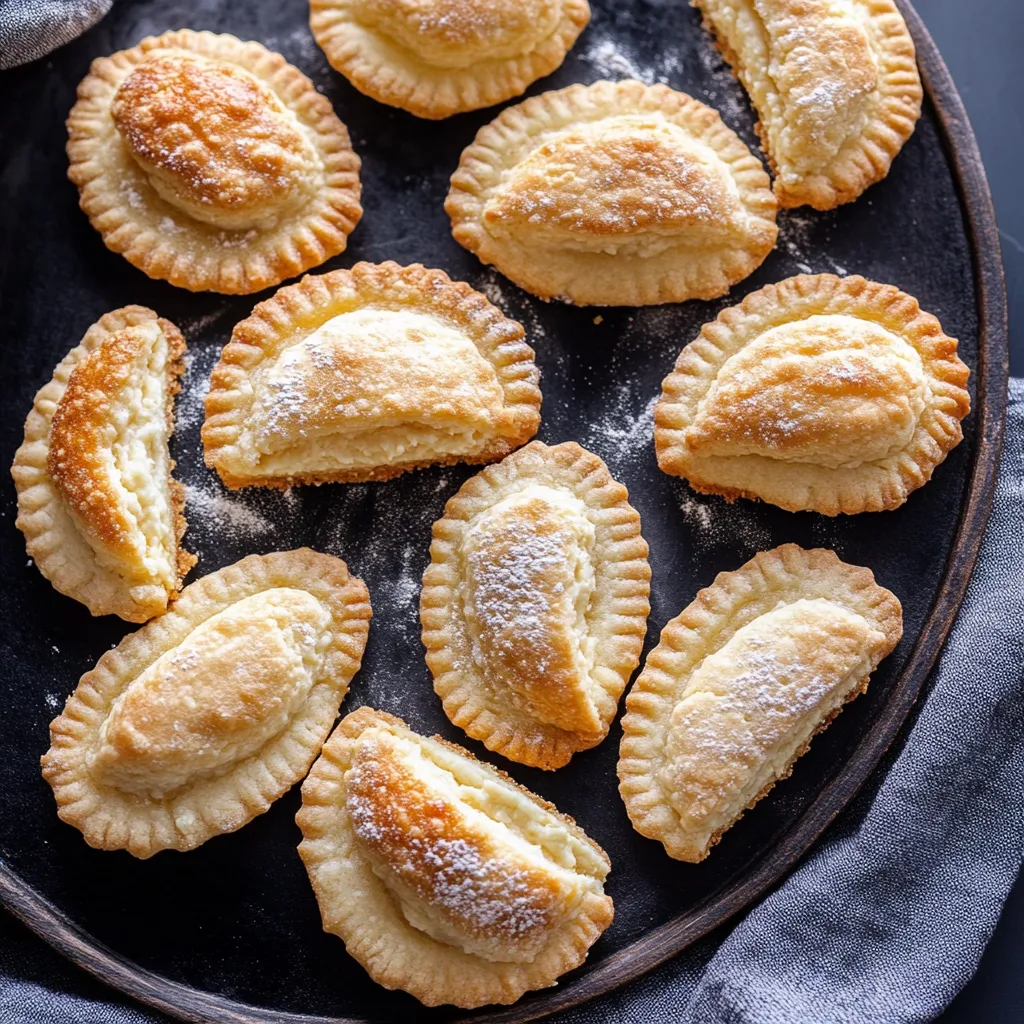 Pin it
Pin it
This traditional Sochniki recipe brings the beloved Eastern European sweet cheese cookies right to your kitchen. The perfect balance of buttery cookie dough wrapped around a creamy cheese filling creates an irresistible treat that's both comforting and elegant. The slight tanginess of the cheese filling pairs beautifully with the sweet, tender cookie exterior.
I first discovered these cookies while exploring my grandmother's handwritten recipe collection. After making them for a holiday gathering, they quickly became the most requested treat among friends and family who had never experienced these traditional delights before.
Ingredients
- Filling Cream cheese 16 oz room temperature: Ensures a smooth filling without lumps
- Farmers cheese 2 lb: Provides authentic texture and slight tanginess
- Egg 1: Binds the filling and adds richness
- Sugar 1 cup: Sweetens the filling to balance the tanginess
- Dough Unsalted Butter 2 cups room temperature: Creates a tender, flaky texture
- Eggs 3: Provides structure and richness to the dough
- Sugar 1/2 cup: Adds sweetness without overpowering
- Flour 6 cups: Forms the base of the cookie dough use unbleached all purpose for best results
- Baking powder 1 tbsp: Gives the perfect rise without making them too cakey
- Salt 1 tsp: Enhances all flavors and balances sweetness
- Topping Egg 1: Creates a beautiful golden sheen when baked
- Sugar 1/2 cup: Adds a delightful crunch and extra sweetness
Step-by-Step Instructions
- Prepare the Filling:
- Combine cream cheese and farmers cheese in a large bowl, ensuring both are at room temperature for the smoothest texture. Add one egg and one cup of sugar, then mix thoroughly until completely incorporated and silky smooth. The filling should be thick enough to hold its shape but still soft enough to spread. Set aside while preparing the dough.
- Create the Cookie Dough Base:
- In a separate large bowl, combine room temperature butter, three eggs, and half cup of sugar. Whisk vigorously until the mixture becomes light and fluffy with a pale yellow color. This aerates the dough for a better texture. The butter must be soft enough to incorporate easily but not melted.
- Develop the Dough Structure:
- Add two cups of flour, the baking powder, and salt to your butter mixture. Whisk gently until just combined. The salt is crucial here as it balances the sweetness and enhances the buttery flavor. Continue adding the remaining flour gradually, about a cup at a time, switching to hand mixing or a dough hook when it becomes too thick for a whisk.
- Form the Perfect Texture:
- Work the dough until it comes together into a cohesive mass that's soft but not sticky. The dough should feel similar to play dough in consistency. If it sticks to your hands, add a bit more flour, one tablespoon at a time. Allow the dough to rest for 15 minutes to let the gluten relax for easier rolling.
- Roll and Shape:
- On a lightly floured surface, roll the dough to an even 1/4 inch thickness. This thickness ensures the cookies will bake evenly while still being sturdy enough to hold the filling. Use a 3inch round cutter to create perfect circles. Gather and reroll scraps until all dough is used.
- Fill and Fold:
- Place about a tablespoon of the cheese filling on one half of each dough circle, leaving a 1/4 inch border around the edge. Be careful not to overfill or the filling may leak during baking. Gently fold the other half of the dough over to create a halfmoon shape. Press the edges firmly to seal, using a fork to create decorative crimped edges if desired.
- Prepare for Baking:
- Arrange the formed cookies on parchment lined baking sheets, leaving about 1 inch between each cookie. Whisk one egg in a small bowl until frothy, then use a pastry brush to lightly coat the top of each cookie. Immediately sprinkle with sugar before the egg wash dries for the best adherence.
- Bake to Perfection:
- Place the cookies in a preheated 400°F oven and bake for approximately 15 minutes. Watch carefully as they approach the 12 minute mark. The cookies should develop a beautiful golden color across the top and slightly darker edges. The bottoms should be lightly browned but not dark.
 Pin it
Pin it
The farmers cheese is truly the star ingredient in this recipe. I remember watching my grandmother carefully select the perfect farmers cheese at our local European market. She always said the quality of the cheese determines the quality of the sochniki. When I make these now, that first bite instantly transports me back to her tiny kitchen filled with the aroma of these baking.
Storage Solutions
Sochniki can be stored in an airtight container at room temperature for up to 3 days, though they rarely last that long in my house. For longer storage, refrigerate them for up to a week. The flavor actually develops nicely after the first day, with the cookie portion softening slightly from the moisture in the filling, creating an even more harmonious texture. To freeze, place fully cooled cookies in a single layer on a baking sheet until frozen solid, then transfer to freezer bags for up to 3 months. Thaw overnight in the refrigerator before serving.
Ingredient Substitutions
While traditional farmers cheese gives the most authentic flavor, you can substitute with well drained cottage cheese processed until smooth. In a pinch, ricotta cheese with a bit of sour cream works wonderfully too. If you prefer a less sweet version, reduce the sugar in the filling to 3/4 cup. For a more modern twist, add 1 teaspoon of lemon zest or vanilla extract to the filling. The dough can be made with half whole wheat flour for a nuttier flavor profile, though you may need to adjust the total amount slightly.
Serving Suggestions
Sochniki truly shine when served slightly warm with a dusting of powdered sugar on top. They make an elegant addition to a brunch spread or afternoon tea. For a more indulgent dessert, serve with a small dollop of sweetened whipped cream and fresh berries on the side. In Eastern European households, these are often enjoyed as a special breakfast treat on weekends or holidays. For a beautiful presentation, arrange on a cake stand with fresh mint leaves or edible flowers for color.
 Pin it
Pin it
The sochniki offer a delightful harmony of sweet and tangy flavors, making them a timeless dessert worth savoring.
Frequently Asked Questions
- → What kind of cheese is best for Sochniki?
Traditional Sochniki use farmers cheese (tvorog) combined with cream cheese for the filling. This combination provides the ideal texture and authentic flavor. If farmers cheese is unavailable, you can substitute with well-drained cottage cheese, though the texture will be slightly different.
- → Can I make the dough for Sochniki in advance?
Yes, the dough can be prepared up to 24 hours in advance and refrigerated. Wrap it tightly in plastic wrap to prevent drying. Allow the dough to come to room temperature for about 30 minutes before rolling for easier handling.
- → Why are my Sochniki opening during baking?
This typically happens when the edges aren't sealed properly. After folding the dough over the filling, press the edges firmly together. You can also use a fork to crimp the edges, ensuring they stay sealed during baking.
- → How should I store leftover Sochniki?
Store cooled Sochniki in an airtight container at room temperature for up to 2 days, or refrigerate for up to 5 days. They can also be frozen for up to 3 months. Reheat briefly in the oven before serving for the best texture.
- → Can I add flavors to the cheese filling?
Absolutely! While traditional Sochniki have a simple sweet cheese filling, you can add vanilla extract, lemon zest, or even raisins to the filling. Some variations include a hint of cinnamon or a dash of rum extract for added flavor.
- → What's the best way to achieve the right texture for Sochniki dough?
The key is to add flour gradually until you achieve a soft but manageable dough that doesn't stick to your hands. Different brands of flour absorb moisture differently, so adjust as needed. Avoid overworking the dough to keep the cookies tender rather than tough.
